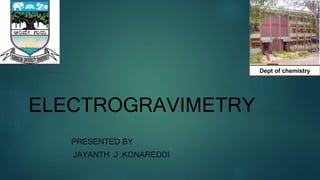
Electrogravimetry: Constant Current & Potential Electrolysis Methods
- 1. ELECTROGRAVIMETRY PRESENTED BY JAYANTH .J .KONAREDDI Dept of chemistry
- 2. contents INTRODUCTION THEORY APPARUTUS ELECTROLYTIC SEPARATION APPLICATION
- 3. INTRODUCTION In Electrogravimetric analysis , the element to be determined is deposited electrolytically upon a suitable electrode and the amount of product is determined by weighing the dry electrode before and after exhaustive analysis. The co-deposition of two metals can often be avoided under the carefully controlled experimental condition. It has numerous advantages.
- 4. THEORY Electrodeposition is governed by OHM’s law and FARADAY’s law of electrolysis. Ohm’s law : The current (I) is directly proportional to electromotive force E and inversely proportional to the resistance R. Faraday’s law : The amount of substance liberated (or dissolved) at the electrode of a cell are directly proportional to quantity of electricity which passes through the solution. W C×t = Z C×t where W = wt. of of the substance deposited, C = current in amperes, t = time in sec Z = constant of proportionality, called electrochemical eq. When C = 1 amp; t = 1s, then W = Z.
- 5. Types of electrogravimetry methods • THERE ARE TWO TYPES OF ELECTROGRAVIMETRY METHODS 1. CONSTANT CURRENT ELECTROLYSIS 2. CONSTANT POTENTIAL ELECTROLYSIS
- 6. 1.Costant current electrolysis Herein electrodeposition carried out by keeping constant current.Here periodic increase in the applied potential are required as the electrolysis proceeds. Apparatus: It consists of suitable cell, direct current source and two electrodes Cells: Two cells are dip in container electrode connected to circuit Cathode: Working electrode is a large surface area use platinum gauze cylinder (-ve electrode) Anode: It is a solid rod with attached to electrical rotating motor connected to cathode to external circuit (+ve electrode) 6-12V storage battery used for DC power supply An ammeter and voltmeter used to indicate current and applied voltage respectively
- 7. 2. Constant potential electrolysis It is possible to separate two elements whose deposition potentials differ sufficiently(by a few tenths of a volt) It is made up of independent electrical circuits that shares a common electrode Working electrode where analyte is deposited The electrolysis circuit consists of a DC source, a potentiometer that permits the voltage applied between the working electrode and counter electrode to be continuously varied and a current meter The control circuit made up of a reference electrode(SCE),a high digital meter and working electrode Control circuit continuously monitors the voltage between working electrode and reference electrode and maintains it at a controlled value
- 8. Electrolytic separation Determination of copper: Principle: Copper may be deposited from either HNO3 or H2SO4 but usually mixture of 2 acids is implied, if such solution is electrolyzed with an EMF of 2-3V then the following reactions Reactions: cathode cu 2+ + 2e- cu ; 2H + + 2e- H2 anode 4OH- O2 + 2H2O + 4e- The acid concentration must not to be great,otherwise deposition will not adhere to the cathode. Nitrite ions acts as a depolarizer at the cathode. NO3 + 10H + +8e- NH4 + + 3H2O The reduction potential of NO3 ions is lower than discharge potential of hydrogen,so H2 is not liberated. HNO3 must be free from HNO2 bcoz the NO2 ions hinder the complete deposition,so the HNO2 may be removed boiling of HNO3
- 9. Procedure: Dissolve 1g of CuSo4 or 0.25g of Cu in 1:1 HNO3 boil to remove HNO2 fumes, just neutralize with the ammonia Acidified with dil.H2SO4 and dilute to 100cm3. The solution(HNO3 100cm3) may contain 0.2-0.3g Cu Add 2cm conc.H2SO4, 1cm conc HNO3 and transfer to electrolytic vessel Clean, dry and weigh platinum guaze electrode Assemble the apparatus with magnetic stirrer,cover the beaker, switch on the stirrer and adjust potential difference 3- 4V and current to 2-4A Continue the electrolysis until blue colour disappears Reduce the current to 0.5-1A, test the completeness of deposition by rinsing the split clock glass Rising the level of liquid by adding 0.5cm of distilled water. Electrolytsis continue for the next 20 minutes If no copper is deposited on fresh surface of cathode,electrolysis is complete Lower the vessel and rise the electrodes, wash the cathode. Break the circuit, dip the cathode into beaker of distilled water and rinse it with acetone Dry at 373-383Kfor 3minutes and weigh after cooling Calculate the copper content of solution after the cathode has been weighed, it shold be cleaned with HNO3 and reweighed. The loss in weight will serve as a check.
- 10. Determination of some other elements IONS Weighed on Electrolyte Conditions Co2+ Co Ammonical sulphate solution 4A; 3-4V Ni2+ Ni Ammonical solution 4A; 3-4V Zn2+ Zn KOH solution 4A; 3.5-4.5V Cd2+ Cd KCN forming K2[Cd(CN)4] 1.5-2A; 2.5-3V
- 11. Applications of ELECTROGRAVIMETYRY Electrogravimetry used for determination of concentration of chemical elements very accurate and precisely in quantitative analysis In organic electrosynthesis it is used by organic chemist for conducting oxidation and reduction In solution of different species are separated by selectively plating out and removing out.It is used in electrochemical methods for removing interference It is used in purification – removal of trace metals from reagents by plating them onto large Hg pool electrode NOTE: *electrosynthesis: synthesis of chemical compounds in a electrochemical cell